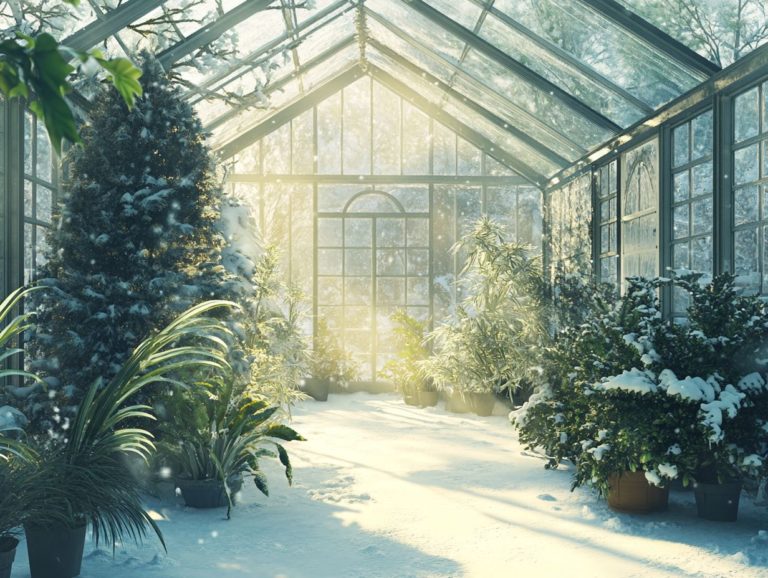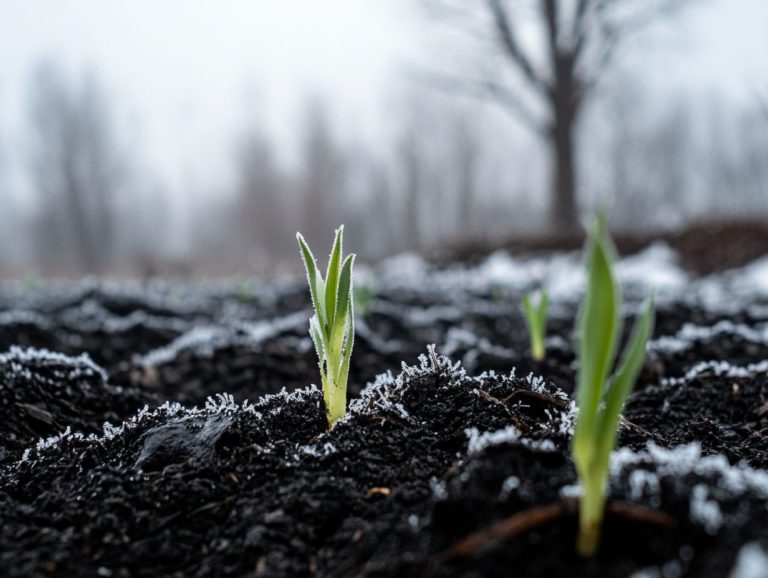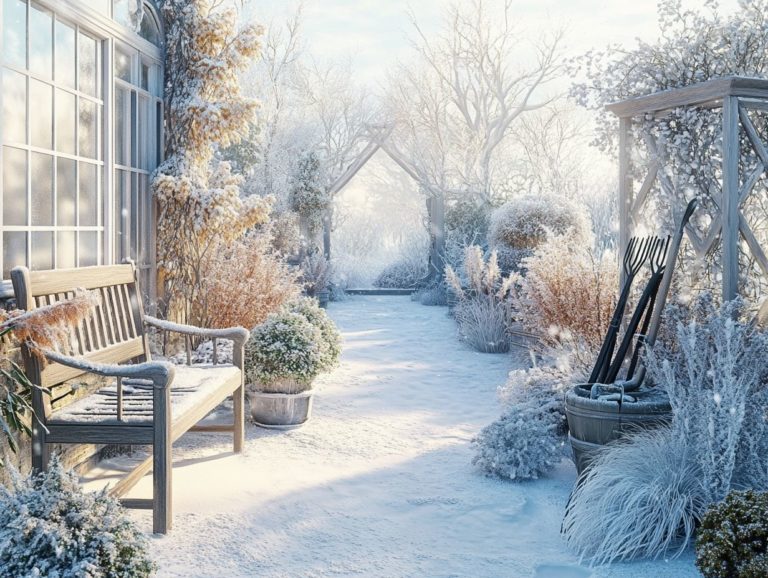Essential Cold-Climate Gardening Resources
Cold-climate gardening might seem daunting, but it offers fantastic benefits for passionate gardeners. Get ready to explore the unique opportunities that await you in chilly regions.
From choosing resilient plants to mastering the right tools, this guide will lead you through nurturing a flourishing garden despite the cold.
Discover how to prepare your garden for winter, maintain it throughout the year, and tap into resources that will enrich your gardening experience.
Embrace the challenge and transform your outdoor space into a robust sanctuary, regardless of the weather!
Contents
- Key Takeaways:
- Benefits of Cold-Climate Gardening
- Essential Tools and Equipment for Cold-Climate Gardening
- Preparing Your Garden for Cold Weather
- Choosing the Right Plants for Cold-Climate Gardening
- Tips for Maintaining a Cold-Climate Garden
- Resources for Cold-Climate Gardening
- Frequently Asked Questions
- 1. What essential tools do I need for cold-climate gardening?
- 2. Where can I find essential cold-climate gardening resources?
- 3. What should I look for when purchasing cold-climate gardening resources?
- 4. How can I prepare my garden for a cold climate?
- 5. Are there any online resources for cold-climate gardening?
- 6. Can I still have a successful garden in a cold climate?
Key Takeaways:
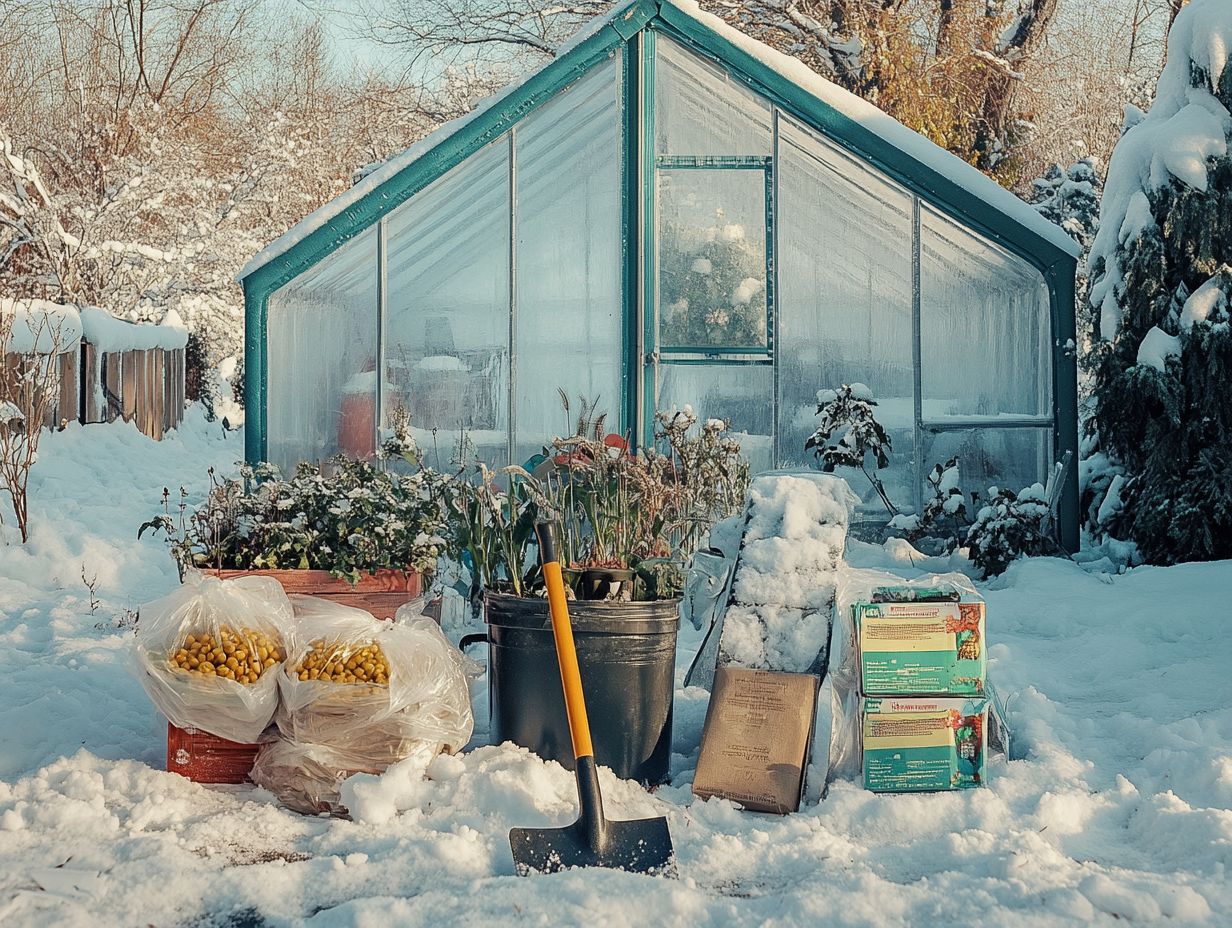
- Cold-climate gardening gives you unique benefits, like longer growing seasons and natural pest control.
- Essential tools include insulated gloves, frost blankets, and a greenhouse for optimal growing.
- Winterizing your garden and picking hardy plants are keys to your success. Regular care and smart resources will help you thrive!
What is Cold-Climate Gardening?
Cold-climate gardening is about cultivating plants during chilly winter months, especially in regions where low temperatures and frost can disrupt traditional gardening methods. By using techniques like cold frames, row covers, and mini hoop houses, you can keep your vegetable garden thriving even when the snow starts to fall.
Rick Stone from Our Stoney Acres emphasizes the need to adapt gardening practices for colder climates, particularly in places like Utah, where seasonal challenges arise. With the right strategies for extending the growing season, you can enjoy a bountiful harvest year-round.
In this endeavor, greenhouses and high tunnels are essential for successful cold-weather gardening. They create small areas with different weather conditions that warm up just enough to nurture hardy vegetables. Timing is crucial early spring and late fall are your best bets for planting crops indoors, giving you an extended growing season and better yields.
The key difference between cold-weather gardening and traditional methods lies in your crop selection. Focus on varieties that thrive in cooler conditions. Options like kale, spinach, and carrots not only withstand frost but also develop richer flavors when grown in the chill, showcasing the distinctive advantages of this gardening approach.
Benefits of Cold-Climate Gardening
Engaging in cold-climate gardening presents you with a wealth of benefits, allowing you to harvest food throughout the year while enjoying the beauty of winter landscapes.
This approach not only enables you to cultivate hardy vegetables but also enhances your organic gardening practices by fostering a sustainable food source through efficient resource utilization.
Winter gardening lets you enjoy fresh produce in colder months something that traditional gardening methods often fail to provide.
Advantages and Opportunities
The advantages of cold-weather gardening are truly varied, presenting you with unique opportunities to adapt your practices and thrive amidst challenging conditions. By using cold frames and row covers, you can create microclimates that protect hardy vegetables from harsh winter elements, allowing for an extended growing season. This adaptability not only maximizes your production but also deepens your appreciation for the diverse array of vegetables that can flourish in colder climates.
In your cold-weather garden, you can cultivate crops like carrots, spinach, and kale well into the chilly months, providing nutritious options for your culinary creations even during winter. Using strategies like mini hoop houses and greenhouses allows you to capture sunlight and maintain warmer air temperatures, significantly enhancing your growing conditions.
These structures can be customized to fit your garden space, making them accessible for both novice and seasoned gardeners alike. The ability to grow these resilient plants not only boosts food sustainability but also inspires others to embark on their own cold-weather gardening adventures. This approach yields fresh produce while contributing to a vibrant, year-round gardening culture.
Essential Tools and Equipment for Cold-Climate Gardening
To excel in cold-climate gardening, having the right tools is essential for your garden’s success. Using essential gardening tools for cold climates optimizes plant growth and protects your garden during winter.
Items like cold frames, row covers, and mini hoop houses are critical. They provide vital insulation against freezing temperatures. For a more substantial impact, larger structures such as greenhouses and high tunnels can create a controlled environment.
Armed with the right tools, you can successfully cultivate a diverse array of vegetables and herbs, even in the most challenging winter conditions.
Must-Have Items
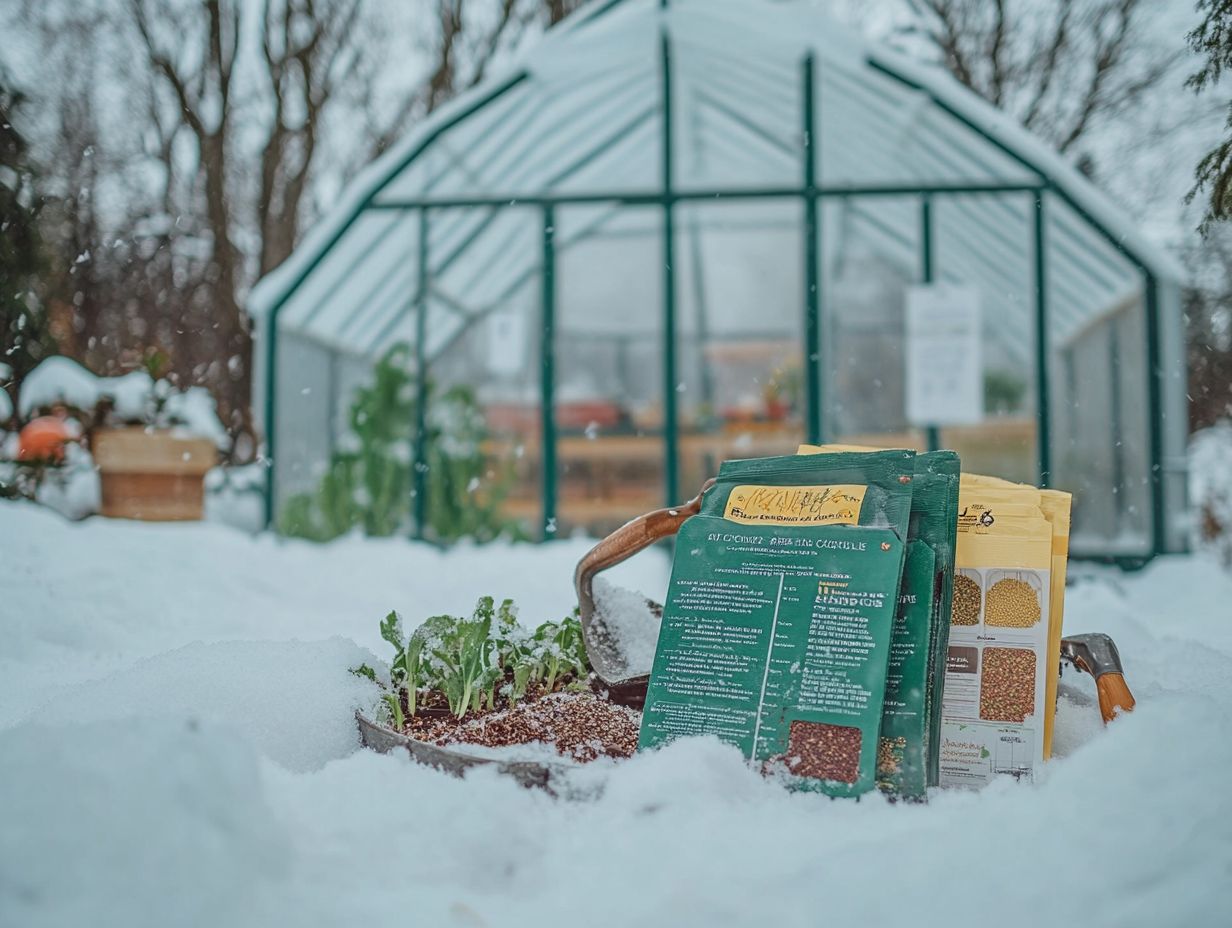
- Cold frames
- Row covers
- Greenhouses
- High tunnels
Some essential items for effective cold-climate gardening include cold frames and row covers. These tools are essential for cold-climate gardening, vital for shielding delicate plants from frost, ensuring they thrive despite the chill.
You can also use greenhouses and high tunnels to create an ideal environment for cultivating hardy vegetables throughout the winter months. These methods not only boost plant survival but also foster the growth of cold-resistant crops like Swiss chard and Napa cabbage, while also allowing the potential to grow Oyster mushrooms.
Cold frames, for instance, act as a protective barrier against harsh winds and frigid temperatures. They create a microclimate, which is a small area that has a different climate from its surroundings, encouraging early germination and extending your harvest. Row covers, typically crafted from lightweight fabric, can be effortlessly draped over your plants, shielding them from sudden cold snaps while still allowing sunlight and moisture to flow through.
Greenhouses provide an even broader canvas for vegetable production, enabling crops such as kale and carrots to flourish year-round. If space is a concern, high tunnels serve as an excellent alternative, offering similar benefits on a smaller scale.
These gardening aids not only extend your growing season but also allow you to experiment with a diverse array of plant varieties. Get ready for an exciting gardening adventure this winter!
Preparing Your Garden for Cold Weather
Preparing your garden for the chill of winter requires careful attention to several key steps that will help you transition smoothly from the vibrant late summer blooms to a flourishing winter landscape.
Begin by winterizing your garden. This includes adding protective layers and applying mulch to shield your plants from frosty conditions. You can also plant certain crops indoors to extend your harvest season and maximize your yield.
It’s crucial to focus on proper timing and thoughtful crop selection, as these factors will determine which plants can not only survive but truly thrive in the colder months ahead.
Steps for Winterizing Your Garden
Winterizing your garden involves a thoughtful process aimed at safeguarding your plants and ensuring their survival. Start by assessing your garden’s microclimates to pinpoint areas that might need extra protection for hardy vegetables like Bok Choy and kale.
By employing effective mulching techniques and using protective coverings, you can shield your plants from frost and harsh weather conditions.
Understanding the different zones within your garden will guide you in identifying the most vulnerable spots. Adding blankets of mulch can insulate the soil effectively. For example, spreading a layer of straw or shredded leaves helps retain warmth and suppress pesky weeds. Think about using row covers or tunnels to create a toastier microclimate for those vegetables that are resilient against the chill.
These strategies not only provide protection but also promote vigorous growth. This allows crops like Brussels sprouts and winter radishes to thrive even when the temperatures dip. Regular monitoring of your garden will help you catch any signs of stress early on, setting the stage for a fruitful spring harvest.
Choosing the Right Plants for Cold-Climate Gardening
Selecting the ideal plants for cold-climate gardening is essential to securing successful winter harvests. Hardy vegetables such as carrots, spinach, and kale are excellent choices. They can thrive in lower temperatures and even benefit from a touch of frost.
Incorporating perennials and considering indoor planting broadens your gardening options. This allows you to enjoy a continuous supply of fresh produce throughout the chillier months.
Hardy and Resilient Plant Options
When selecting hardy and resilient plant options for cold-climate gardening, it’s crucial to choose varieties that can withstand and flourish in lower temperatures. Choose hardy vegetables that can thrive in lower temperatures. Options like Swiss chard, Napa cabbage, and Bok Choy are great for late summer gardening.
These plants establish beautifully before winter arrives and can be harvested throughout the colder months. If you’re eager to enjoy fresh produce year-round, planting crops indoors is an excellent alternative for your Utah garden.
Take certain varieties of kale, for instance they’re not just able to survive cold weather; they actually improve in flavor after a frost. This makes them a beloved choice among gardeners, especially when considering timing and crop selection.
Similarly, root vegetables like carrots and beets can remain in the ground, allowing you to harvest food year-round as needed. This ensures a steady supply of fresh food during winter.
Indoor gardening opens up the possibility of cultivating herbs and greens like basil and lettuce, which thrive under controlled conditions. This approach not only extends your growing season but also guarantees that, even in the harshest climates, a nutritious winter harvest is always at your fingertips.
Tips for Maintaining a Cold-Climate Garden
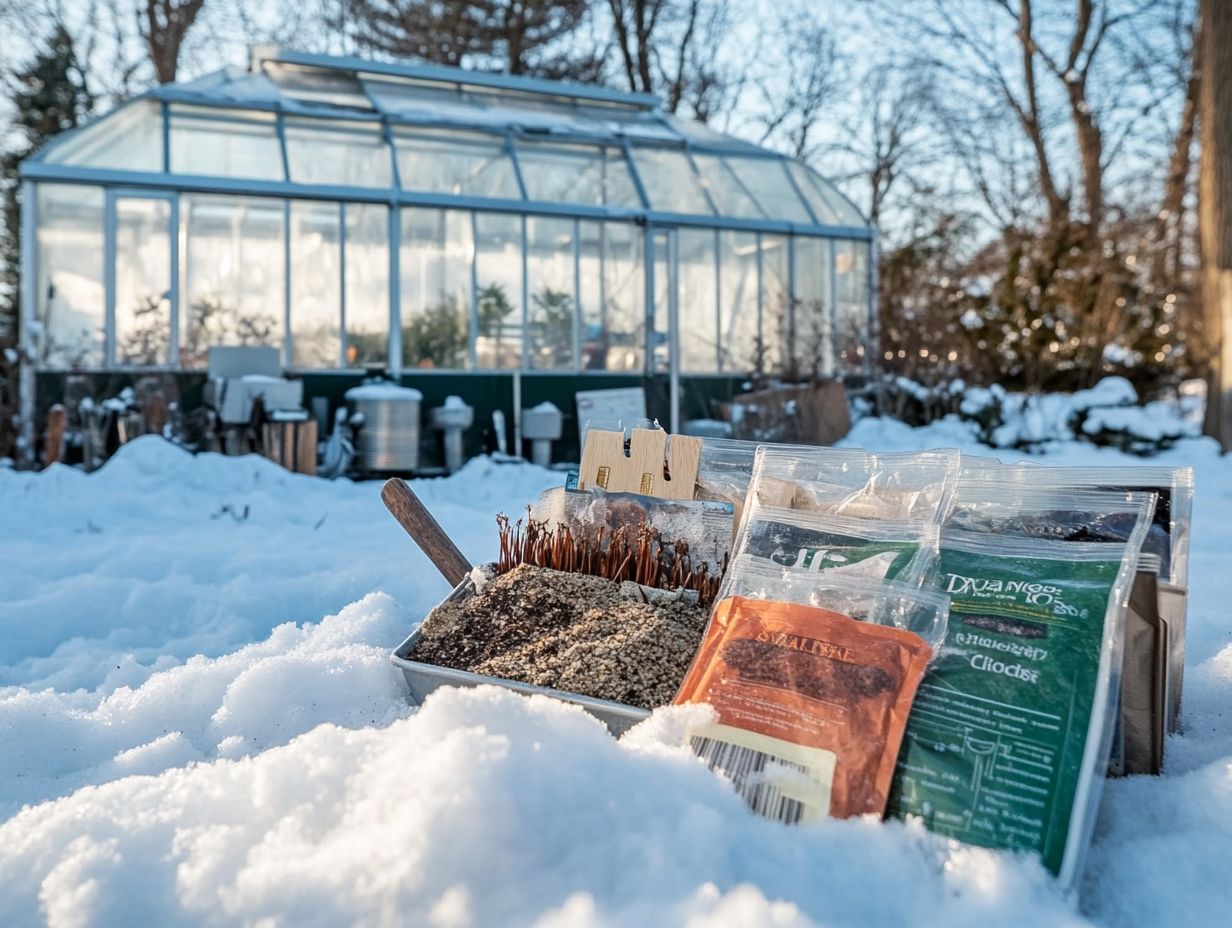
Maintaining a cold-climate garden also involves gardening in winter, demanding year-round strategies that keep your plants thriving and productive. To get the most out of your efforts, consider exploring the top 10 gardening books for cold-climate enthusiasts. By embracing organic gardening practices, you can significantly enhance plant health and bolster their resilience against the biting cold.
Consistently monitoring and adjusting protective measures, such as row covers protective fabric that shields plants from cold and cold frames is crucial for adapting to the shifting winter conditions. This proactive approach makes winter gardening not just possible but a rewarding adventure!
Year-Round Maintenance Strategies
Year-round maintenance is essential to keep your cold-climate garden thriving. Conducting routine checks on your plants can help you spot early signs of frost damage or pest infestations before they escalate.
Utilizing protective measures like row covers or mulch not only provides warmth but also acts as a shield against harsh winds and temperature fluctuations. Adjusting your watering schedules to prevent over-saturation is essential, as frozen soil can lead to root rot.
Emphasizing organic practices, such as composting and using natural fertilizers, along with oyster mushroom cultivation, promotes soil health and boosts your plants’ immunity. These strategies strengthen your garden during winter. They also create a thriving environment for abundant harvests in spring!
Resources for Cold-Climate Gardening
Accessing reliable resources for cold-climate gardening, including insights from Rick Stone and Our Stoney Acres, can truly elevate your gardening experience and expand your knowledge. For instance, The Essential Guide to Gardening in Cold Weather offers invaluable tools, including insights into successful techniques for thriving in colder weather while also connecting you with fellow enthusiasts.
Engaging with these resources not only provides you with practical advice but also cultivates a sense of community among gardeners facing the unique challenges that winter gardening presents. Curious about where to find the best tips? Dive into updating your cold-climate gardening resources and empower your gardening journey today!
Websites, Books, and Communities for Further Guidance
Numerous websites, books, and communities serve as excellent resources for anyone keen on cold-climate gardening.
Northern Gardening offers tailored advice on plant selection and seasonal planting schedules for frost-prone regions, including insights on essential gardening apps for cold climates.
For a deeper dive, The Winter Garden showcases how to maximize productivity even in the most challenging climates.
The Reddit community r/gardening is a treasure trove for enthusiasts. You can exchange tips and share experiences about which crops thrive under snow.
Frequently Asked Questions
1. What essential tools do I need for cold-climate gardening?
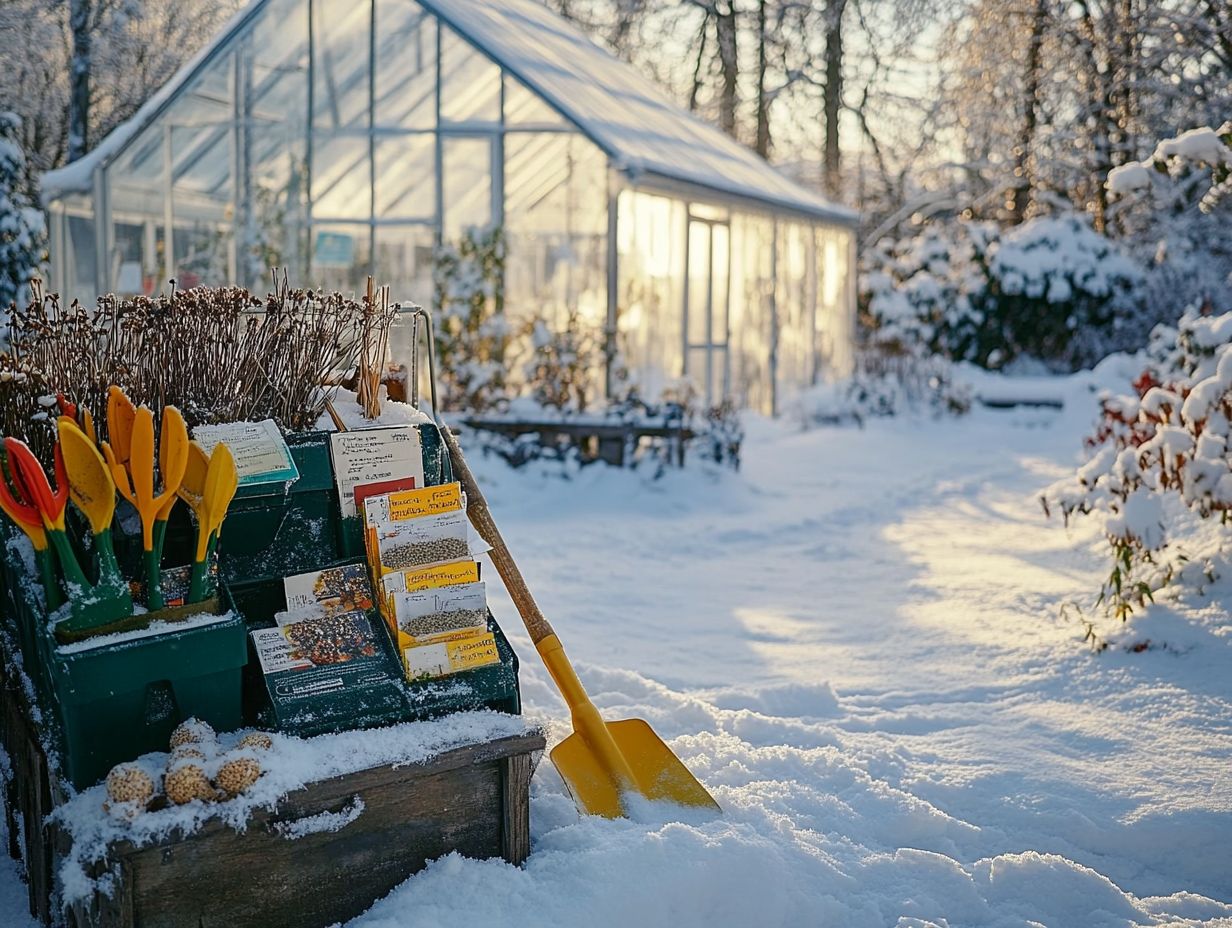
Essential cold-climate gardening resources include hardy plants like Bok Choy and essential cold-climate gardening techniques necessary for successful gardening in colder climates.
Knowing the best planting times and using frost-resistant plants will enhance your success.
2. Where can I find essential cold-climate gardening resources?
You can find essential cold-climate gardening resources at local garden centers, online retailers, and through gardening clubs. For more detailed information, check out resources available for cold-climate gardeners. Gathering insights from experienced gardeners in your area is also beneficial.
3. What should I look for when purchasing cold-climate gardening resources?
When purchasing, focus on materials designed for colder climates, including frost-resistant plants and protective coverings.
4. How can I prepare my garden for a cold climate?
Choose hardy plants, such as kale and Swiss chard, that can withstand freezing temperatures. Insulate your soil with mulch, and consider utilizing cold frames or greenhouses to extend your growing season.
5. Are there any online resources for cold-climate gardening?
Yes, numerous online resources offer a wealth of articles, videos, and forums with information on plant selection, soil preparation, and frost protection.
6. Can I still have a successful garden in a cold climate?
Absolutely! With the right resources and knowledge, you can cultivate a thriving garden in a cold climate. Start planning today, and enjoy a beautiful and productive garden all year round!


